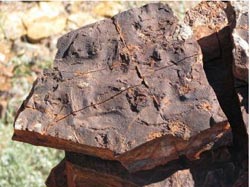Evidence of 3.5 billion-year-old bacterial ecosystems found in Australia

A rock surface is displaying "polygonal oscillation cracks" in the 3.48 billion years old Dresser Formation, Pilbara region, Western Australia. Such and similar sedimentary structures are of biological origin. They document ancient microorganisms that formed carpet-like microbial mats on the former sediment surface. The Dresser Formation records an ancient playa-like setting -- similar environments are occurring on Mars as well. The MISS constitute a novel approach to detect and to understand Earth's earliest life. <br><br>Credit: Nora Noffke<br>
Earth's oldest sedimentary rocks are not only rare, but also almost always altered by hydrothermal and tectonic activity.
A new study from a team including Carnegie's Nora Noffke, a visiting investigator, and Robert Hazen revealed the well-preserved remnants of a complex ecosystem in a nearly 3.5 billion-year-old sedimentary rock sequence in Australia. Their work is published in Astrobiology.
The Pilbara district of Western Australia constitutes one of the famous geological regions that allow insight into the early evolution of life. Mound-like deposits created by ancient photosynthetic bacteria, called stromatolites, and microfossils of bacteria have been described by scientists in detail. However, a phenomenon called microbially induced sedimentary structures, or MISS, had not previously been seen in this region. These structures are formed from mats of microbial material, much like mats seen today on stagnant waters or in coastal flats.
The team included Noffke, Hazen, Daniel Christian of Old Dominion University, and David Wacey of the University of Western Australia. They described various MISS preserved in the region's Dresser Formation. Advanced chemical analyses point toward a biological origin of the material.
The Dresser MISS fossils resemble strongly in form and preservation the MISS from several other younger rock samples, such as a 2.9 billion-year-old ecosystem Noffke and her colleagues found in South Africa.
“This work extends the geological record of MISS by almost 300 million years,” said Noffke, who is also a professor at ODU. “Complex mat-forming microbial communities likely existed almost 3.5 billion years ago.”
The team proposes that the sedimentary structures arose from the interactions of bacterial films with shoreline sediments from the region.
“The structures give a very clear signal on what the ancient conditions were, and what the bacteria composing the biofilms were able to do,” Noffke said.
MISS are among the targets of Mars rovers, which search for similar formations on that planet's surface. Thus, the team's findings could have relevance for studies of our larger Solar System as well.
This work was supported by the NSF Paleobiology and Sedimentary Geology program, NASA Astrobiology Institute, NASA Exobiology and Evolutionary Biology Programs, and the Deep Carbon Observatory and the Carnegie Institution for Science.
The Carnegie Institution for Science is a private, nonprofit organization headquartered in Washington, D.C., with six research departments throughout the U.S. Since its founding in 1902, the Carnegie Institution has been a pioneering force in basic scientific research. Carnegie scientists are leaders in plant biology, developmental biology, astronomy, materials science, global ecology, and Earth and planetary science.
Old Dominion University is a forward-focused public, research university with its main campus in Norfolk, Va. Research specialties of the university's College of Sciences include those in geobiology, geochemistry, geophysics and oceanography.
Media Contact
More Information:
http://www.ciw.eduAll latest news from the category: Earth Sciences
Earth Sciences (also referred to as Geosciences), which deals with basic issues surrounding our planet, plays a vital role in the area of energy and raw materials supply.
Earth Sciences comprises subjects such as geology, geography, geological informatics, paleontology, mineralogy, petrography, crystallography, geophysics, geodesy, glaciology, cartography, photogrammetry, meteorology and seismology, early-warning systems, earthquake research and polar research.
Newest articles

Properties of new materials for microchips
… can now be measured well. Reseachers of Delft University of Technology demonstrated measuring performance properties of ultrathin silicon membranes. Making ever smaller and more powerful chips requires new ultrathin…

Floating solar’s potential
… to support sustainable development by addressing climate, water, and energy goals holistically. A new study published this week in Nature Energy raises the potential for floating solar photovoltaics (FPV)…

Skyrmions move at record speeds
… a step towards the computing of the future. An international research team led by scientists from the CNRS1 has discovered that the magnetic nanobubbles2 known as skyrmions can be…




















